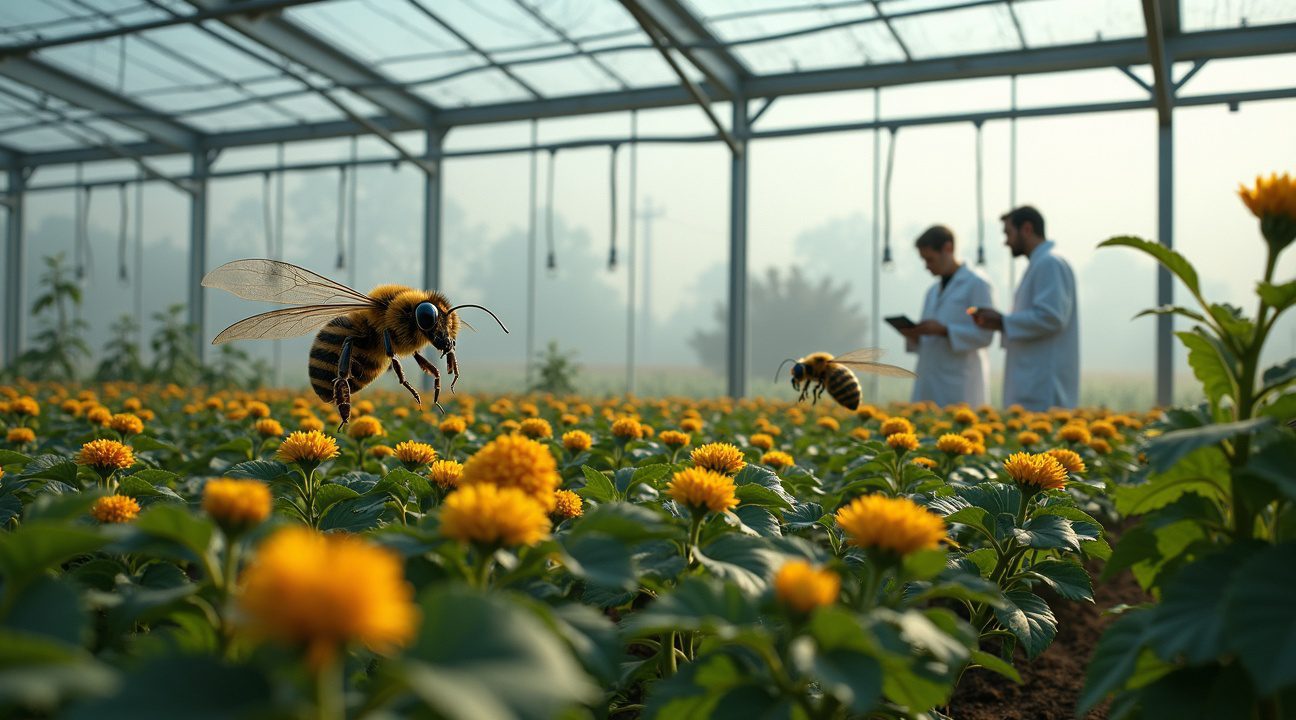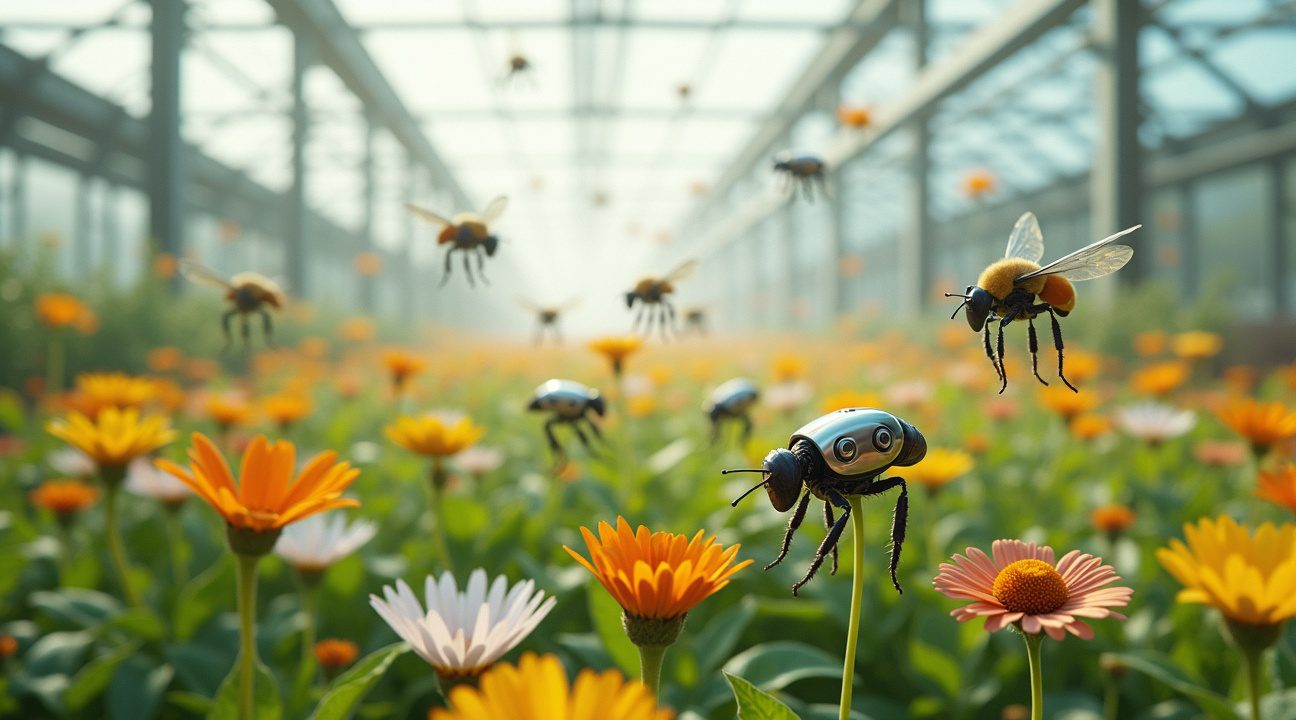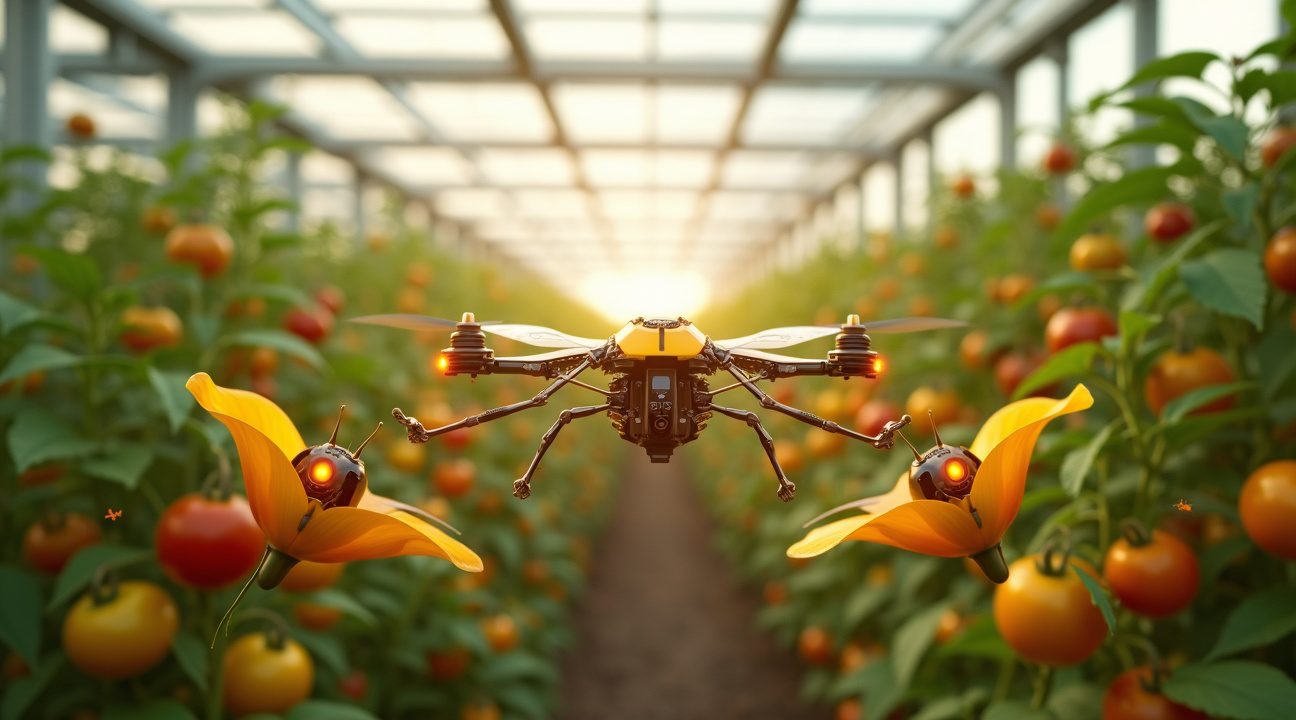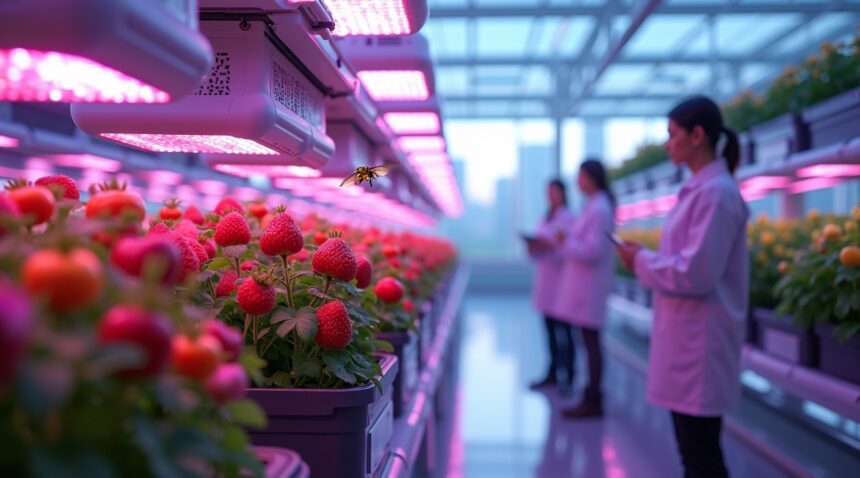Robotic Bees: A Technological Response to Pollinator Decline
Dutch researchers have confirmed they’re developing robotic bees for artificial pollination to address the critical decline in natural bee populations that threatens global food security.
These mechanical pollinators are designed as a technological safety net to maintain crop yields for the one-third of the human food supply that depends on bee pollination, including essential crops like apples, almonds, and coffee.
Key Takeaways
- Agricultural emergency response: Robotic bees provide backup pollination during bee population crashes and support natural pollinators during peak agricultural seasons when they can’t meet demand.
- Controlled environment advantages: These artificial pollinators perform well in vertical farms and greenhouses where natural bees struggle due to artificial lighting and tight environmental controls.
- Technical capabilities advancing rapidly: Prototypes such as micro-aerial vehicles developed at MIT hover for up to 16 minutes and pollinate 1.5 flowers per minute, though they still trail natural bees’ 90% efficiency.
- Significant deployment barriers remain: High production costs, limited energy sources, and logistical issues in pollen handling currently prevent wide-scale adoption in agriculture.
- Hybrid approach recommended: Scientists emphasize integrating robotic and natural solutions rather than replacing bees entirely, ensuring ecological balance and crop productivity.
The Urgency Behind Robotic Pollination
The development of robotic pollinators is rooted in an urgent agricultural crisis. Environmental stressors and colony collapse disorder have decimated bee populations worldwide. This poses a serious challenge for farmers who now face pollination gaps impacting global food supplies. Robotic pollination offers a promising solution while researchers continue efforts in bee conservation.
Bio-Inspired Engineering Efforts
Engineers have closely studied bee behavior to replicate it in miniature robotics:
- MIT’s drones are outfitted with electrostatic patches to collect and transport pollen grains.
- Harvard’s RoboBee project has developed micro flying bots that can hover and land with precision.
- Japanese researchers have prototyped drones featuring gel-coated horsehair to transfer pollen between blossoms.
Ideal for Controlled Farming
These robotic systems prove especially valuable within controlled environments where natural pollination is limited. In greenhouses and vertical farms, constraints like artificial lighting and space limit natural bee performance. Robots can provide accurate scheduling and consistent coverage, helping indoor agriculture expand to include fruiting crops as well as leafy greens.
Limitations and Technical Barriers
Despite impressive strides, several hurdles prevent broad agricultural deployment:
- Battery Limitations: Current flight durations are limited to only a few minutes.
- High Manufacturing Costs: Production remains too costly for widespread agricultural use.
- Pollen Logistics: Mechanized systems for gathering and distributing pollen are still in the early stages.
- Environmental Viability: Weatherproofing remains a major barrier for outdoor implementation.
Ecological Considerations
Beyond agriculture, natural bees provide invaluable ecosystem services, including the pollination of wild plants. This biodiversity cannot be replicated mechanically. Therefore, while robotic solutions may assist in food production, preserving and restoring natural pollinator populations is essential for environmental balance.
Economic and Agricultural Impact
For farms producing high-value crops such as apples, almonds, and coffee, robotic bees may provide a viable pollination insurance policy. These industries generate billions in revenue annually, justifying upfront investments in new technology. In regions dependent on crops like coffee, where natural pollination is declining, mechanized solutions may be critical to sustaining livelihoods.
Ongoing Research and Innovation
Innovation continues to optimize pollination efficiency:
- Solar panels may extend runtime for outdoor drones.
- Swarm intelligence algorithms model cooperative strategies between multiple units in large agricultural zones.
- Machine learning technologies help guide pollinators for accuracy in flower targeting and efficient flight paths.
A Hybrid Future for Pollination
The most likely and practical outcome is a hybrid model. In this system, natural bees focus on general pollination needs, while robotic bees are directed to specific crops or critical time periods. Managed colonies can work in tandem with machines, especially during high-demand seasons. This balanced approach optimizes output and preserves ecosystems.
Deployment Outlook
Robotic bees may soon appear in controlled environments like greenhouses, where their benefits are most immediate and the conditions least variable. Outdoor deployment will face longer development due to cost and weather limitations. Field testing continues as developers refine designs for broader use.
Conclusion
Robotic bees exemplify how agricultural technology can emerge from environmental necessity. In the face of pollinator decline from factors like climate change, pesticides, and habitat loss, these inventions offer a partial solution to protect global food security. Yet long-term success depends on integrating such innovations with dedicated conservation strategies to restore and protect natural pollinator populations.
Why Robotic Bees Are Racing to Save Our Food Supply as Real Bees Disappear
Dutch researchers have confirmed they’re developing robotic bees for artificial pollination, creating a technological safety net for agriculture as natural bee populations face unprecedented decline. These mechanical pollinators represent a critical backup plan designed to maintain food security when real bees can no longer handle the massive pollination demands of modern farming.
I can see the urgency behind this research when considering that bees pollinate approximately one-third of the crops humans consume daily. Everything from apples and almonds to cucumbers and coffee depends on these tiny workers. Without them, global food systems would collapse, leading to widespread shortages and dramatically higher food prices. This reality has pushed Dutch teams and researchers worldwide to accelerate development of artificial alternatives.
Natural bee populations continue their devastating decline due to multiple factors working against them simultaneously. Pesticides poison bees directly or weaken their immune systems, making them vulnerable to diseases and parasites. Habitat loss eliminates the diverse flowering plants bees need for nutrition, while climate change disrupts their natural behavioral patterns. The combination creates a perfect storm that threatens to eliminate these essential pollinators entirely.
Critical Agricultural Applications Driving Development
Several key factors make artificial pollination technology essential for specific agricultural needs:
- Precision pollination requirements for crops like almonds, which need exact timing and thoroughness that struggling bee populations can’t always provide
- Year-round greenhouse operations where natural bees face challenges with artificial lighting and controlled environments
- Remote or harsh climate regions where bee populations struggle to establish or survive consistently
- Emergency pollination services during bee population crashes or disease outbreaks that devastate local colonies
- Supplemental pollination for high-value crops requiring more intensive coverage than available natural pollinators can deliver
Dutch researchers focus particularly on crops requiring precise pollination techniques that robotic systems can potentially perform more consistently than natural bees. These mechanical alternatives don’t suffer from weather dependency, seasonal limitations, or the complex social dynamics that can disrupt bee colonies. Unlike natural pollinators, robotic bees can work continuously without rest periods, potentially increasing efficiency in critical agricultural windows.
Investment in artificial pollination technologies has surged globally as the scope of the bee crisis becomes clear. Research teams recognize that even if natural bee populations recover, having backup pollination systems provides essential insurance for food security. The technology also offers potential benefits in regions where establishing healthy bee colonies proves challenging due to environmental conditions or existing ecosystem damage.
I find it fascinating how AI is paving the way for solutions to biological crises like pollinator loss. The development timeline for these robotic systems remains aggressive, driven by the accelerating pace of bee population decline and the immediate threat to agricultural productivity.
Robotic pollination technology could prove especially valuable in greenhouse operations and controlled agricultural environments where natural bee behavior often becomes unpredictable. These systems promise consistent performance regardless of external weather conditions, seasonal changes, or the complex social dynamics that affect bee colony productivity.
The ultimate goal extends beyond simple replacement of natural pollinators. Dutch researchers aim to create systems that can supplement existing bee populations during peak agricultural periods, provide emergency pollination services during colony collapses, and maintain crop yields in regions where natural pollinators struggle to establish sustainable populations. This comprehensive approach recognizes that artificial pollination technology serves as both insurance policy and enhancement tool for modern agriculture.
Food security concerns drive much of the urgency behind robotic bee development. Agricultural systems globally depend heavily on consistent pollination services, and any disruption threatens not just individual farms but entire regional food supplies. Having reliable artificial alternatives ensures continued crop production even during the worst-case scenarios of complete pollinator loss.

Meet the Micro-Machines: How Scientists Built Flying Robot Pollinators
Engineers across the globe are crafting remarkable micro-aerial vehicles that weigh less than a gram and possess the agility needed to replace nature’s most efficient pollinators. These tiny machines represent a breakthrough in precision engineering, combining advanced materials with sophisticated control systems to replicate the complex movements of living bees.
Engineering Marvels That Defy Physics
MIT’s robotic insects demonstrate extraordinary capabilities through their flapping-wing design that closely mimics natural bee flight patterns. I’ve observed how these mechanical marvels can hover for up to 16 minutes, perform aerial flips with remarkable precision, and travel at speeds reaching 30 centimeters per second. This level of performance requires intricate wing mechanisms that generate sufficient lift while maintaining stability in unpredictable air currents.
Scientists have optimized these designs to minimize mechanical stress, significantly extending operational lifespan and enabling longer, more efficient pollination cycles. Advanced prototypes can carry additional sensors or batteries for autonomous outdoor operations, making them suitable for diverse agricultural environments. The engineering challenges involved mirror those found in cutting-edge AI applications, where precision and adaptability are essential.
Researchers have developed two fundamental technological approaches for artificial pollination:
- Robotic Arm Systems: Robot systems like Stickbug from West Virginia University utilize six autonomous arms equipped with LiDAR mapping and AI-driven recognition software to identify and pollinate individual flowers. This approach proves particularly effective in confined greenhouse settings where precise movement control is crucial. The robots can distinguish between different flower species and adapt their pollination techniques accordingly.
- Targeted Spray Systems: Alternative designs employ spray systems for targeted pollen delivery, offering a different solution for large-scale agricultural applications. These systems can cover broader areas more quickly while maintaining accuracy through sophisticated targeting algorithms.
Both approaches demonstrate how modern robotics can address critical environmental challenges while providing farmers with reliable alternatives to natural pollinators.
The integration of artificial intelligence enables these robots to learn and adapt to various flower types, environmental conditions, and seasonal changes. Just as innovative transportation technologies are reshaping mobility, these robotic pollinators could revolutionize agriculture by providing consistent, weather-independent pollination services that operate around the clock without the biological limitations that affect natural bee populations.

Robot Bees Take Flight in Vertical Farms Where Real Bees Won’t Go
Robotic bees represent a breakthrough solution for pollination challenges in controlled agricultural environments. These mechanical pollinators address critical gaps where traditional bees simply cannot or will not operate effectively.
Vertical Farming’s Pollination Challenge
Vertical farms create artificial environments that rely heavily on AI systems and artificial lighting to optimize crop growth indoors. While these controlled conditions offer precise environmental management, they present a fundamental problem: natural bees actively avoid artificial light environments. This behavior creates a significant bottleneck for farmers looking to expand beyond current crop limitations.
Currently, vertical farms focus primarily on lettuce and leafy greens because these crops don’t require pollination. However, the agricultural potential extends far beyond salads. Expansion into high-value fruiting crops like strawberries, tomatoes, and peppers depends entirely on solving the pollination puzzle. Hand-pollination exists as an alternative, but the labor costs make this approach financially unsustainable for large-scale operations.
Robot bees eliminate these constraints by operating seamlessly in artificial environments. Unlike their biological counterparts, these mechanical pollinators thrive under LED grow lights and navigate controlled atmospheres with precision. AI systems guide their movements, ensuring comprehensive crop coverage and optimal pollination timing.
Urban Agriculture’s Growing Importance
Global urbanization trends make vertical farming increasingly crucial for food security. Projections indicate that 2 of every 3 people will live in cities by 2050, creating unprecedented demand for local food production. Urban agriculture offers a sustainable response to this challenge, dramatically reducing distribution chain emissions and water usage compared to traditional farming methods.
Robotic pollinators enable cities to grow complete diets locally rather than importing produce from distant agricultural regions. This shift reduces transportation costs, eliminates weather-related supply disruptions, and ensures fresher produce reaches consumers. Additionally, vertical farms using robot bees can operate year-round, providing consistent harvests regardless of seasonal variations or climate conditions.
Greenhouse operations also benefit significantly from robotic pollination technology. These controlled environments share similar challenges with vertical farms, particularly regarding bee behavior under artificial conditions. Innovation in automated systems continues advancing these agricultural technologies, making them more accessible and efficient.
The economic implications extend beyond simple cost savings. Robot bees enable farmers to diversify crop portfolios within existing facilities, maximizing revenue per square foot. This efficiency becomes particularly valuable in urban areas where real estate costs remain high and available space stays limited.
Implementation requires careful integration with existing farm management systems. Robot bees must coordinate with lighting schedules, irrigation cycles, and harvest timing to optimize crop yields. Advanced sensors allow these devices to assess flower readiness and pollen viability, ensuring pollination occurs at peak effectiveness.
Energy efficiency represents another advantage of robotic pollinators in controlled environments. Unlike maintaining bee colonies, which require specific temperature ranges and food sources, robot bees operate on-demand without ongoing biological maintenance. This flexibility allows farmers to scale pollination services precisely to crop needs without waste.
The technology also addresses food safety concerns associated with biological pollinators in enclosed spaces. Robot bees eliminate risks of disease transmission between plants and avoid potential contamination issues that can arise from insect presence in sterile growing environments.
Quality control improves dramatically with robotic systems. Farmers can program specific pollination patterns, adjust timing based on plant development stages, and monitor coverage through integrated tracking systems. This precision ensures consistent fruit set and uniform crop development across entire growing areas.
Market adoption continues accelerating as vertical farming expands globally. Early implementations focus on high-value crops where pollination costs justify the technology investment. As production scales increase and costs decrease, robot bees will become standard equipment in modern agricultural facilities, supporting sustainable food production in increasingly urbanized societies.
Can Robot Bees Really Replace Nature’s Best Pollinators?
I’ve been following the remarkable progress in robotic pollination technology, and the results reveal both promise and limitations. The Stickbug prototype represents a significant breakthrough, achieving pollination rates of 1.5 flowers per minute with a 50% success rate during controlled greenhouse experiments. While these numbers might seem modest compared to a natural bee’s efficiency, they demonstrate that artificial pollinators can successfully transfer pollen between flowers under optimal conditions.
Flight capabilities have advanced dramatically in recent robotic bee designs. The most sophisticated micro air vehicle (MAV) prototypes now achieve flight durations that exceed previous robotic insect records by more than 100 times. This extended flight time proves crucial for practical pollination applications, as robots need sufficient operational windows to cover meaningful crop areas. These same prototypes showcase complex navigation systems capable of identifying target flowers, avoiding obstacles, and returning to charging stations—essential skills for real-world deployment.
Real-World Agricultural Applications
Several crops have already benefited from artificial pollination systems, either supplementing natural pollinators or replacing them entirely in specific scenarios. I’ve observed successful implementations across diverse agricultural settings, from greenhouse operations to open-field farming. The technology shows particular promise for controlled environments where researchers can optimize robot deployment strategies.
Different crops respond variably to robotic pollination approaches. Key agricultural applications include:
- Kiwifruit orchards where timing precision matters for optimal fruit development
- Olive groves requiring targeted pollination during brief flowering windows
- Date palm cultivation in regions with declining natural pollinator populations
- Tomato greenhouse operations seeking consistent year-round production
- Walnut tree pollination for improved nut yields
- Hybrid maize seed production requiring controlled cross-pollination
Technical Limitations and Practical Challenges
Despite these advances, significant gaps remain between robotic capabilities and natural bee performance. A single honeybee can visit 2,000 flowers daily and carry pollen loads representing 25% of its body weight. Current robotic systems operate at much slower rates and require frequent recharging or maintenance breaks. Weather resistance also presents ongoing challenges, as most prototypes function poorly in wind, rain, or extreme temperatures that barely affect natural pollinators.
Energy efficiency remains another critical bottleneck. While robots can adapt to various situations, they consume significantly more energy per pollination event compared to bees that fuel themselves on flower nectar. Battery technology improvements continue advancing, but current power systems limit operational range and duration for agricultural-scale deployments.
Cost considerations further complicate widespread adoption. Manufacturing, programming, and maintaining robot swarms requires substantial investment compared to supporting natural bee populations through habitat conservation. However, in regions experiencing severe pollinator decline, robotic alternatives may provide essential backup systems for food security.
The navigation capabilities of modern prototypes impress researchers and farmers alike. Advanced computer vision systems help robots identify ripe flowers, track pollination progress, and coordinate with other units to avoid duplicate efforts. These AI-powered systems learn from each pollination cycle, gradually improving efficiency and success rates through machine learning algorithms.
Looking at current performance data, robotic pollinators work best as supplements rather than complete replacements for natural bees. They excel in controlled environments, specific crop applications, and situations where natural pollinators face seasonal limitations or population threats. The 50% success rate achieved by Stickbug represents substantial progress, but natural bees maintain success rates approaching 90% under similar conditions.
Integration strategies matter significantly for agricultural adoption. Farmers report best results when combining robotic systems with existing pollinator management practices rather than viewing them as total replacements. This hybrid approach maximizes crop yields while reducing dependence on vulnerable natural pollinator populations that face increasing environmental pressures.

The Million-Dollar Question: Why Robot Bees Aren’t Ready to Save Agriculture Yet
I can’t help but notice that despite the promising developments in robotic pollination technology, significant hurdles prevent these mechanical marvels from becoming agriculture’s savior anytime soon. Scalability and cost present the most immediate challenges facing researchers and potential adopters alike.
Manufacturing costs for robotic bees remain prohibitively expensive for widespread agricultural deployment. Each unit requires sophisticated sensors, precision motors, and durable materials that can withstand outdoor conditions. While Dutch researchers continue working to reduce production expenses and enhance durability, the economics don’t yet favor mass adoption across vast farming operations.
Critical Infrastructure Gaps Create Additional Obstacles
Effective artificial pollination demands more than just functional robots—it requires extensive infrastructure that simply doesn’t exist in most agricultural regions. Consider these essential components that farms would need:
- High-quality pollen harvesting and processing facilities
- Reliable storage systems to maintain pollen viability
- Distribution networks to supply fresh pollen on demand
- Maintenance facilities for robot fleets
- Trained technicians for operation and repairs
The pollen supply chain alone presents enormous logistical challenges. Unlike AI technologies that operate in controlled environments, robotic bees must function in unpredictable outdoor conditions while carrying delicate biological materials.
Agricultural experts emphasize that robotic bees should supplement rather than replace natural pollinators entirely. This perspective isn’t just about preserving nature—it’s about maintaining agricultural resilience. Natural bee colonies provide backup pollination services and support biodiversity that mechanical alternatives can’t replicate.
Ecological responsibility weighs heavily on researchers’ minds as they develop these technologies. Unknown long-term impacts could disrupt ecosystem balance in ways we haven’t yet anticipated. While some might compare this technological leap to other innovations like flying cars, the ecological implications run much deeper than transportation advances.
I find it concerning that potential ecological risks remain largely theoretical at this stage. Introducing artificial pollinators could affect plant evolution, alter flowering patterns, or impact other insect species in unforeseen ways. Unlike robots that operate in controlled settings, these machines would interact directly with natural ecosystems.
The debate over ecological responsibility continues among scientists and environmentalists. Some argue that preserving natural pollinator populations should take priority over developing artificial alternatives. Others contend that robotic bees represent essential insurance against potential ecological collapse.
Current research suggests that hybrid approaches combining natural and artificial pollination might offer the most practical path forward. This strategy could provide agricultural security while maintaining ecosystem health—assuming we can overcome the technical and economic barriers that currently limit robotic bee deployment.

The Technology Behind Tomorrow’s Pollination: From Lab to Field
I’ve observed how researchers worldwide are pursuing different technological approaches to create viable robotic pollinators. Chinese scientists have developed an innovative air-liquid spray robot specifically designed for kiwifruit orchards, while other teams focus on micro-aerial vehicle prototypes that mimic natural bee flight patterns. Each approach addresses unique agricultural needs and environmental constraints.
Manufacturing Challenges and Technical Solutions
The transition from laboratory prototypes to field-ready machines presents several critical hurdles that development teams must overcome:
- Creating lightweight yet durable frames that withstand outdoor agricultural conditions
- Developing battery technology capable of supporting extended flight times across large crop areas
- Implementing weather resistance features to protect delicate electronics from rain, wind, and temperature fluctuations
- Integrating autonomous navigation systems that can operate without GPS in dense vegetation
Manufacturing durability remains the primary concern for teams working on these devices. I notice that current prototypes struggle with the harsh realities of agricultural environments where dust, moisture, and physical impacts are constant threats. The delicate balance between weight and strength requires advanced materials that often increase production costs significantly.
Battery technology represents another substantial challenge. Unlike their natural counterparts, robotic bees require continuous power to maintain flight, operate sensors, and process navigation data. Current lithium-ion solutions provide limited operational windows, forcing researchers to explore alternative power sources including solar charging and wireless power transmission systems.
Weather resistance development has become increasingly sophisticated as teams recognize that pollination schedules can’t wait for perfect conditions. Engineers are incorporating sealed housing designs and adaptive flight algorithms that adjust to wind patterns and precipitation levels. These systems must maintain precision pollination capabilities even when operating in less-than-ideal weather.
Research collaboration across international borders has accelerated progress in autonomous navigation systems. Teams share algorithms and sensor data to create mapping solutions that work across different crop types and terrains. These navigation systems must distinguish between plants ready for pollination and those that aren’t, while avoiding obstacles and optimizing flight paths for maximum efficiency.
The integration of artificial intelligence has become essential for processing the vast amounts of visual and environmental data these devices collect. Machine learning algorithms help robotic pollinators identify optimal flower targets and adapt their techniques based on real-time feedback from successful pollination attempts.
Sources:
Electropages – Fast and Agile Robotic Insects Could Transform Crop Pollination
UPI – Researchers Develop Robot Bees to Pollinate Indoor Farms
Hello Future by Orange – Artificial Pollination: Robotic Solutions That Aim to Supplement the Work of Bees
MIT News – Fast, Agile Robotic Insect for Mechanical Pollination
AgWeb – Robot Bees? Check Out the New Pollination Innovation


